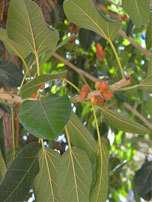Nyagrodha

Botanical Name : Ficus benghalensis Linn
Family : Moraceae
Introduction :
It is one of the good medicine useful for skin disease. This is one of the plant can act as key stone species of the forest.
Names in different Indian languages :
English : Banyan tree
Hindi : Bat, bargad
Kannada : Ala
Malayalam : Peral, vatavriksham
Sanskrit : Nyagrodha
Tamil : Alamaram, peral
Telugu : peddamarri
Unani : Bargad, Darakht-e-Reesh
Synonyms :
Vata, Nyagrodha, Bahupaada, Dhruv.
Varieties & adulterants – (CV – controversy, AD – adulterants) :
Ficus Elastica
ficus glomerata
Morphology :
Large sized tree grows up to 30 m height, it have aerial roots, to to this it can spread large number of branches even hectares.
Leaves – simple, alternate, broadly elliptic
Flower- hypanthodium inflorescence
Fruit – axillary , sessile , reddish when ripe
Distribution & Habitat :
All over India
Chemical constituents :
Phytosterolin, bengalenoside, flavonoid glycosides, leucocyanidin and leucopelargonidin
Properties :
RASA-kashaya, madhura
GUNA-guru
VIRYA-sitha
VIPAKA-katu
Karma :
Grahi, stanbana, vrana hara, sophahara, varnya, vataprakopanam
Acrid, depurative, ophthalmic, antiarthritic , anti emetic
Indication :
diabetes, dysentery, and in seminal weakness, leucorrhoea, menorrhagia, nervous disorders, erysipelas, burning sensation
Milky juice and seeds—applied topically to sores, ulcers, cracked soles of the feet, rheumatic inflammations.
Buds—a decoction in milk is given in haemorrhages.
Part used :
Root, aerial root, leaves , bark, latex, fruit
Important Yogas or Formations :
Panchavalkaladi ghridha and taila, naalpamaradi kashya and taila
Therapeutic Uses :
Leaves— useful for promoting suppuration in abscess.
Bark decoction useful in skin disease
Fruit juice useful in stop vomiting